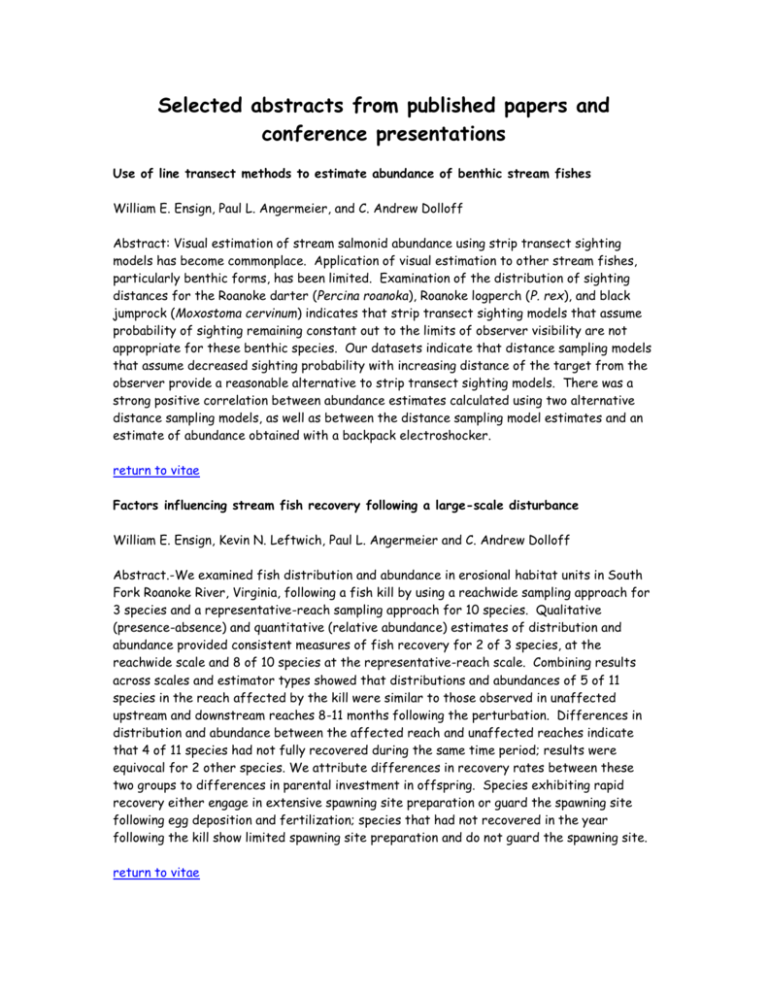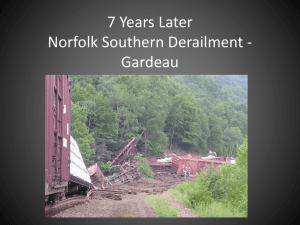Use of line transect methods to estimate abundance of benthic
advertisement

Selected abstracts from published papers and conference presentations Use of line transect methods to estimate abundance of benthic stream fishes William E. Ensign, Paul L. Angermeier, and C. Andrew Dolloff Abstract: Visual estimation of stream salmonid abundance using strip transect sighting models has become commonplace. Application of visual estimation to other stream fishes, particularly benthic forms, has been limited. Examination of the distribution of sighting distances for the Roanoke darter (Percina roanoka), Roanoke logperch (P. rex), and black jumprock (Moxostoma cervinum) indicates that strip transect sighting models that assume probability of sighting remaining constant out to the limits of observer visibility are not appropriate for these benthic species. Our datasets indicate that distance sampling models that assume decreased sighting probability with increasing distance of the target from the observer provide a reasonable alternative to strip transect sighting models. There was a strong positive correlation between abundance estimates calculated using two alternative distance sampling models, as well as between the distance sampling model estimates and an estimate of abundance obtained with a backpack electroshocker. return to vitae Factors influencing stream fish recovery following a large-scale disturbance William E. Ensign, Kevin N. Leftwich, Paul L. Angermeier and C. Andrew Dolloff Abstract.-We examined fish distribution and abundance in erosional habitat units in South Fork Roanoke River, Virginia, following a fish kill by using a reachwide sampling approach for 3 species and a representative-reach sampling approach for 10 species. Qualitative (presence-absence) and quantitative (relative abundance) estimates of distribution and abundance provided consistent measures of fish recovery for 2 of 3 species, at the reachwide scale and 8 of 10 species at the representative-reach scale. Combining results across scales and estimator types showed that distributions and abundances of 5 of 11 species in the reach affected by the kill were similar to those observed in unaffected upstream and downstream reaches 8-11 months following the perturbation. Differences in distribution and abundance between the affected reach and unaffected reaches indicate that 4 of 11 species had not fully recovered during the same time period; results were equivocal for 2 other species. We attribute differences in recovery rates between these two groups to differences in parental investment in offspring. Species exhibiting rapid recovery either engage in extensive spawning site preparation or guard the spawning site following egg deposition and fertilization; species that had not recovered in the year following the kill show limited spawning site preparation and do not guard the spawning site. return to vitae Summer food limitation reduces brook and rainbow trout biomass in a southern Appalachian stream William E. Ensign, Richard J. Strange and Stephen E. Moore Abstract: - We assessed salmonid production in summer in a second- and third-order montane stream in eastern Tennessee in 1987. We sampled three stream sections, one containing exclusively brook trout Salvelinus fontinalis, one containing exclusively rainbow trout Oncorhynchus mykiss, and a third with a mixture of both species. Population estimates for July and October 1987 revealed reductions in biomass over the 4-month period that ranged from 31 to 49%, whereas population densities declined by 32-46% during the same period. Total net production during the 4-month period was low and ranged from 0.38 to 0.45 g/ml. From June through September, the mean number of prey items per stomach ranged from 4.2 to 29.9, whereas the mean relative weight of stomach contents ranged from 0. 12 to 1. 34 mg dry weight per gram wet weight of fish flesh. There was a strong positive correlation between the mean relative weight of stomach contents and the mean condition factor for a given date. Calculated energy intake was below the level necessary to provide energy for maintenance metabolism. return to vitae Food resource competition in Southern Appalachian brook and rainbow trout William E. Ensign, James W. Habera and Richard J. Strange Food habits of sympatric and allopatric populations of adult brook trout (Salvelinus fontinalis) and rainbow trout (Oncorhynchus mykiss) from 4 streams in the Great Smoky Mountains National Park were compared to determine if competition for food resources might explain the exclusion of the former by the latter in Southern Appalachian streams. When diets of brook trout in sympatry with rainbow trout were compared with diets of brook trout in allopatry, there was little significant change in prey composition. Based on this information, exploitation competition for food resoources does not seem to play a role in the invasion of rainbow trout into areas of Southern Appalachian streams occupied by brook trout. return to vitae The importance of proximal habitat units in explaining benthic riffle fish densities William E. Ensign (Presenter), Paul L. Angermeier and C. Andrew Dolloff In this study we determined the value of riffle area and proximal habitat units in explaining variation in benthic riffle fish densities. Densities of Roanoke darter, Roanoke logperch, and black jumprock were estimated in 45 riffle/run units in Roanoke River, VA using underwater observation. We estimated surface area of target riffles and of pool and riffle units beginning within 250 m of the upstream and downstream edge of the target unit. In addition, measures of water depth, current velocity, and substrate coarseness were obtained from the first pool and riffle immediately upstream and downstream of the target unit. Significant univariate correlations between fish density in target riffles and at least one measure of proximal habitat were obtained for all three species. Multiple regression analysis incorporating those measures provided statistically significant models relating fish density to adjacent habitat unit characteristics. Although there was no relationship between riffle size and fish density, there were differences in the explanatory power of adjacent unit variables among small, medium and large riffles for all three species. Our results are consistent with a model linking habitat use patterns to the life history attributes of the three species. return to vitae Biases of sampling gear and spatial resolution on estimates of microhabitat selection by stream fishes William E. Ensign and Paul L. Angermeier 1. Understanding the habitats selected and avoided by stream fishes requires collection of unbiased data on habitat use and availability. In this study, we assess the relative importance of fright bias and bias associated with the resolution of data collection on perceived microhabitats selected by three species of riffle-dwelling stream fish. 2. To assess fright bias, we compared data on fish positions collected by electroshocking and underwater observation within large (> 40m2) quadrats. When compared to underwater observation, electroshocking samples indicated use of either shallower water, faster water a or a combination of shallower and faster water for all three species, a pattern consistent with cover-seeking behavior (i.e. fright bias). 3. To assess resolution bias, we compared fish position data collected using underwater observation from point locations and from large quadrats. Quadrat-based underwater observations failed to indicate utilization of velocity refuges by two of the three species when compared to point-based samples. Conversely, point-based samples did not adequately represent use of the higher-velocity mesohabitats in which these velocity refuges were embedded. 4. Differences among data sets indicated both fright bias and resolution bias occurred. While resolution bias can be addressed by carefully matching the research question to the appropriate resolution for data collection, fright bias associated with the electroshocking technique we employed is more difficult to address. We recommend the use of underwater observation for collection of habitat selection data whenever feasible. return to vitae Effects of fright bias on sampling efficiency of stream fish assemblages. William E. Ensign, Richard J. Neves and Alan J. Temple Relative efficiencies of three different fish sampling techniques (pre-positioned area shockers, single pass electroshocking, and a combined shocking-seining method) with differing potential to induce fright bias were compared in riffle, run and pool habitats in Roanoke River, Virginia. Twenty-three species were captured by the three techniques. Of the three techniques, pre-positioned area shockers had the highest species accumulation rate in each of the three habitats sampled. The single pass electroshocking method had higher species accumulation rates than the combined technique in pools and runs, whereas the performance of the two techniques was similar in riffles. Pre-positioned area shockers also captured a higher proportion of larger, more mobile individuals than the other two techniques. Based on our results, pre-positioned area shockers were the least biased of the three techniques for sampling riverine fish. return to vitae Diel habitat use by fishes in a Blue Ridge stream, Georgia William E. Ensign and Edward E. Leonard We determined diel habitat use by fishes in a Blue Ridge stream in Georgia using direct underwater observation on two occasions in September 1999. During both day and night sampling periods, individuals in the family Centrarchidae were most commonly found in shallow (< 20 cm depth) and deep (>= 20 cm depth) areas with low water velocities (< 10 cm·s1 average velocity). During the day, representatives of Cyprinidae were most common in deep areas with higher water velocities (> 10 cm·s-1 average velocity) but shifted to shallow areas with low water velocities during the night. Differences in diel habitat use by the two families are best explained by differences in predator avoidance strategies. return to vitae Diet of banded sculpins from Bartow County streams Calley J. Brewer and William E. Ensign Biological monitoring is an important method for assessing the degree of environmental degradation of aquatic systems. One part of biological monitoring is identifying indicator taxa of fish due to their sensitivity to environmental stresses and toxins. A major trend that can be identified with omnivorous fish is that since they are opportunistic feeders they can survive on the resources available. In this study, I assessed the stomach contents of 45 banded sculpin, Cottus carolinae, from excellent/good quality streams and fair/poor quality streams. The majority of the stomach contents were aquatic invertebrates, while some contained fish, crustaceans and terrestrial organisms. In streams of excellent/good quality there was a greater diversity of organisms. Only in these good quality streams were Coleoptera and Odonata found. The fair/poor streams showed less species diversity, more occurrence of empty stomachs and a lower percent occurrence of the organisms that were identified. The information from this study could lead to developing new methods for monitoring biological communities. return to vitae Fish Community Structure along an Ecoregion Boundary William E. Ensign and Joseph M. Dirnberger The use of biological community structure as an indicator of the health and integrity of freshwater aquatic systems is now commonplace. Current applications (i.e. variations on Karr’s IBI and the EPA’s Rapid Bioassessment Procedure) suggest that reference sites and metric criteria developed within ecoregions or physiographic provinces provide the best measure of anthropogenic impact. However, there has been limited analysis of watersheds that span ecoregions or physiographies. In this study we present data on fish community structure from 20 stream sites in the Etowah River watershed (Bartow County, Georgia) draining the Ridge and Valley, Blue Ridge, and Piedmont ecoregions. Hierarchical cluster analysis (average linkage method using Euclidean distances) of sites using the 20 most common species and 20 most abundant species produced site classifications consistent with ecoregion boundaries. In contrast, cluster analysis of sites based on reproductive guilds, trophic guilds and a combination of reproductive and trophic guilds produced classifications consistent with the degree of anthropogenic impact observed at each site. Our results indicate that use of metrics or reference conditions specific to ecoregions for sites along ecoregion boundaries could lead to erroneous assessments of the biological integrity of boundary sites. return to vitae Comparing abiotic and biotic parameters when assessing streams within a geologically diverse area (Bartow County, GA) Joseph M. Dirnberger, William Ensign, Heather Sutton, and Donald McGarey During the summer of 2000, we sampled twenty-two stream sites in Bartow County (Georgia) for fish, macro-invertebrates, water quality, habitat condition, and bacterial indicators as part of a county-wide watershed assessment. Three major geological regions occur within the county (to the west rocks are mainly limestone, to the north shales and sandstones, and to the east and southeast harder metamorphic rocks). Because the county is so geologically diverse yet all sites are within the same drainage basin, this data set provides a rare opportunity to examine the influence of watershed geology within a relatively small geographic area on parameters and metrics traditionally used to assess anthropogenic impacts. Principal component analysis (PCA) and other comparisons indicate that most biotic and abiotic parameters over all sites are related to one another in ways expected among sites that vary due to anthropogenic impacts. Multimetrics developed for fish and for invertebrates reflected trends along the primary PCA 'water quality' factor (turbidity, suspended solids, and BOD), whereas site geology did not reflect trends across this factor. As expected dissolved ions (as well as alkalinity and pH) were strongly related to watershed geology, but other less obvious water quality parameters such as nitrate were also associated with geologic location. Most individual metrics that are traditionally used to assess invertebrate and fish communities did not appear to be influenced by geology, but rather by anthropogenic habitat and water changes. In addition, differences in taxonomic composition of invertebrate communities were associated with watershed geology. Any given invertebrate community within the western limestone region was most similar (based on similarity indices of species composition) to other communities within this same region. Communities within the other two regions were not similar to western communities, but not distinctly different from each other. Because water chemistry between streams of western limestone and streams of northern shale-sandstone are more similar, geological influences on invertebrate species distribution may reflect physical stream characteristics (such as streambed morphology and substrate characteristics) rather than water chemistry. While underlying geology strongly affected many water quality parameters, biotic measures were relatively independent of these water quality effects, indicating biotic parameters are reliable in assessing degradation in a geologically diverse basin. return to vitae Fish Diversity in Bartow County, Georgia William E. Ensign As part of a countywide watershed assessment during Summer 2000, fish diversity and abundance were quantitatively assessed at 22 sites in 14 separate watersheds in Bartow County, Georgia. Watershed area above the sites ranged from 585 to 47,555 hectares. A total of 54 species of fish from 14 families were obtained from the 22 sites. Representatives of Cyprinidae, Centrarchidae and Percidae accounted for the majority of diversity with 16, 12 and 8 species, respectively. Species richness at individual sites ranged from 7 to 26. No species was found at all 22 sites, but Hypentelium etowanum and Lepomis auritus were both found at 21 sites and Cottus carolinae, Percina nigrofasciata and Campostoma oligolepis were found at 20 sites. Seven species were found at only one site and six species occurred at only two sites. Regression of watershed area on species richness explained 24% of the variance in the species richness data. Residual variance in the regression relationship is accounted for, in part, by differences in habitat quality among sites. Sites suffering from environmental perturbation typically had lower species richness, given watershed area, than sites that were less perturbed. return to vitae Investigating hydrologic alteration as a mechanism of fish assemblage shifts in urbanizing streams A.H. Roy, M.C. Freeman, B.J. Freeman, S.J. Wenger, W.E. Ensign, and J.L. Meyer A primary mechanism of urban effects on stream ecosystems is via altered hydrology; increases in impervious cover result in rapid delivery of stormwater to streams creating flashy flows and reduced baseflows. Although it is presumed that these changes in flow regimes can alter fish assemblages, there is little empirical evidence demonstrating relations between fishes and hydrologic alteration. Further, we do not know what aspects of the hydrograph are particularly important in driving fish assemblage structure and what fishes are most affected by these hydrologic alterations in small streams. We measured hydrologic patterns and sampled fish assemblages in 30 small streams (8--20 km2) in the Etowah River basin (Georgia, USA) that were stratified by percent impervious cover (<10%, 10-20%, >20%) and the estimated degree of hydrologic alteration (based on synoptic measurements of baseflow yield). Hydrologic variables were derived from stage gauges at each study site for one year (January 2003--2004). Increased % impervious cover was positively correlated with the frequency, magnitude, and duration of storm events above 50%, 75% and 100% mean stage of the 0.5-year recurrence interval flood during most seasons. Other measures of flashiness such as the rate of the rising and falling limb of the hydrograph were also positively related to impervious cover, except during high flow spring months when soil saturation likely masked any land cover effects. Increased duration of low flows associated with impervious cover only occurred during the autumn low flow period, and this corresponded to significant increases in richness of lentic tolerant species. Altered stormflows in summer and autumn were related to decreased richness of endemic, cosmopolitan, and sensitive fish species, and decreased abundance of lentic tolerant species. Species that were predicted to be sensitive to urbanization based on life history and other attributes were also related to stormflow variables after accounting for variation associated with % fines in riffles. Overall, hydrologic variables explained 20-66% of the variation in fish assemblage richness and abundance. The linkages between hydrologic alteration and stream fishes were potentially complicated by contrasting effects of elevated flows on sediment delivery and scour, and mediating effects of stream gradient. However, stormwater management practices that promote natural hydrologic patterns are likely to reduce the negative effects of impervious cover on stream fish assemblages. return to vitae









